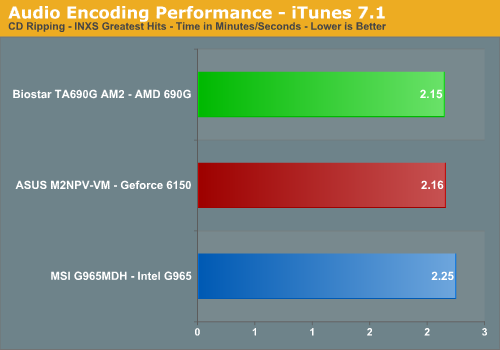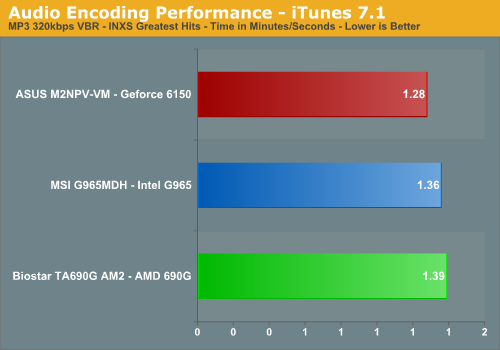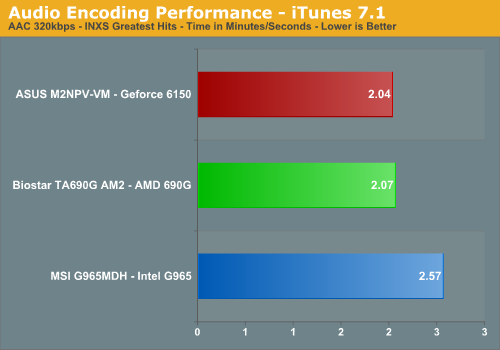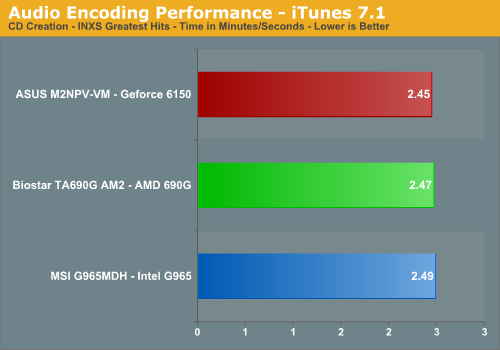Audio Encoding Performance
While the media encoding prowess of the Intel platform seemed to be lacking at times, we expect it to fair a little better on the audio side. Our audio test suite normally consists of Exact Audio Copy v095.b4 and LAME 3.98a3. We did run these tests with basically the same results but for our purposes today we will utilize iTunes 7.1 as it is one of the most utilized audio applications available due to the immense popularity of the iPod.
Our first task was to figure out what test CD to utilize. We needed one that contained a significant number of tracks and had over 600MB of data in order to properly stress our platforms. After rummaging around the lab and discounting the Burl Ives Greatest Christmas Hits album, we happened upon a CD that would work for our purposes as it was not working for anyone else, INXS Greatest Hits. This one time '80s glory masterpiece contains 16 tracks totaling 606MB of songs that was instantly whisked into our anxiously awaiting optical drive.
Our first test consists of utilizing iTunes to rip our INXS CD to WAV format on our hard drive. Even though CPU speed and optical drive selection have a great impact on these test results we are using the same optical drive between platforms for each test.

Our two AM2 platforms score slightly ahead of our Intel setup but the margin is minimal. This test was very consistent with each result never varying more than one second from the base score. Unlike the Nero Recode 2 DVD burning test, in this case our AMD systems did not suffer from drive issues.
Our next two tests have us utilizing iTunes to convert our WAV files into ACC or MP3 compatible formats. We utilize the 320kbps setting for both tests with the MP3 test also utilizing the variable bit rate option.


We usually see iTunes favoring the AM2 platforms in most test results. The results are no different here with both AM2 systems completing the ACC conversion about 50 seconds before the Intel system. In our MP3 conversion, the Intel system places second but the general differences are minimal. We attribute the 6150 performance to better storage controller and CPU throughput although standard memory bandwidth is lower than the other two boards.
Our final test has us creating a legal use copy CD from the base WAV files we collected when ripping the INXS Greatest Hits CD. Not that the world needs anymore of these CDs but it makes for a good closing test. We promise all CDs are destroyed after testing (much to the pleasure of our ears and those at the RIAA).

Once again our test results are extremely close with the optical drive playing a leading role in ensuring our results are fairly close. The minor differences are all attributable to the better disk performance of the NIVIDA 6150/430 combination in this case. We noticed each time that the disk access stopped about two to three seconds quicker with the 6150 platform. This is opposite of our Video Encoding results where each of our AM2 platforms could not keep the optical drive fed properly over the course of a burn session.
While the media encoding prowess of the Intel platform seemed to be lacking at times, we expect it to fair a little better on the audio side. Our audio test suite normally consists of Exact Audio Copy v095.b4 and LAME 3.98a3. We did run these tests with basically the same results but for our purposes today we will utilize iTunes 7.1 as it is one of the most utilized audio applications available due to the immense popularity of the iPod.
Our first task was to figure out what test CD to utilize. We needed one that contained a significant number of tracks and had over 600MB of data in order to properly stress our platforms. After rummaging around the lab and discounting the Burl Ives Greatest Christmas Hits album, we happened upon a CD that would work for our purposes as it was not working for anyone else, INXS Greatest Hits. This one time '80s glory masterpiece contains 16 tracks totaling 606MB of songs that was instantly whisked into our anxiously awaiting optical drive.
Our first test consists of utilizing iTunes to rip our INXS CD to WAV format on our hard drive. Even though CPU speed and optical drive selection have a great impact on these test results we are using the same optical drive between platforms for each test.

Our two AM2 platforms score slightly ahead of our Intel setup but the margin is minimal. This test was very consistent with each result never varying more than one second from the base score. Unlike the Nero Recode 2 DVD burning test, in this case our AMD systems did not suffer from drive issues.
Our next two tests have us utilizing iTunes to convert our WAV files into ACC or MP3 compatible formats. We utilize the 320kbps setting for both tests with the MP3 test also utilizing the variable bit rate option.


We usually see iTunes favoring the AM2 platforms in most test results. The results are no different here with both AM2 systems completing the ACC conversion about 50 seconds before the Intel system. In our MP3 conversion, the Intel system places second but the general differences are minimal. We attribute the 6150 performance to better storage controller and CPU throughput although standard memory bandwidth is lower than the other two boards.
Our final test has us creating a legal use copy CD from the base WAV files we collected when ripping the INXS Greatest Hits CD. Not that the world needs anymore of these CDs but it makes for a good closing test. We promise all CDs are destroyed after testing (much to the pleasure of our ears and those at the RIAA).

Once again our test results are extremely close with the optical drive playing a leading role in ensuring our results are fairly close. The minor differences are all attributable to the better disk performance of the NIVIDA 6150/430 combination in this case. We noticed each time that the disk access stopped about two to three seconds quicker with the 6150 platform. This is opposite of our Video Encoding results where each of our AM2 platforms could not keep the optical drive fed properly over the course of a burn session.










70 Comments
View All Comments
3 CUBED - Friday, March 9, 2007 - link
I have to mention power also. Considering that a HTPC is properly going to be on quiet a bit, I would like to se some info on the power draw, from these mobo's. The same goes in the roundup!! Also considering that the energy prices is headed only UP, even a little lower performance might be worth that in the long run!!Thanks Kasper.
MrNeutrino - Thursday, March 8, 2007 - link
Guys,First, the feedback:
Frankly I'm quite frustrated from waiting for a site like AT for the past half a year or more to come out with more mATX reviews (until this review, which is a start).
I realize there are a lot of gamers OCers out there - very many AT readers. However, there are many (just as many?) non-gamer enthusiasts hoping to run stock-speed,SILENT, SFF systems out there - myself for one.
While lesser known sites have reviewed many of these products, I (and others like me I know of) have been waiting for AT to publish SOMETHING in the mATX / C2D (current and long-standing performance champ depending on the system config.) category for months on end! I realize you have dedicated folks working for each review category. However, AT - a site as a whole - still seems to have enough bandwidth to publish back-to-back LCD and heatsink reviews in a matter of day or two each. Yet you seem to have held off on prioritizing mATX system reviews for some inexplicable milestone until yesterday. I recall reading a vague comment in one of your reviews around the end of the year regarding an 'upcoming' mATX review, if I remember correctly. In my opinion it was already too delayed a review. Little did I know I'd be waiting another two months for such a review.
Geez! Publish the review in parts if you must, but don't make your readers hold off for this long and think all is well! What's the point of releasing this type of review, months after products became widely available and just a few months before the next round of technology updates?!
-----------------------
Second is a set of requests for the (personally) much anticipated upcoming mATX review next week 'as well as' for future reviews:
Requests for the upcoming mATX review:
* Please try to include Asus P5B-VM. One of the currently best featured G965 MBs.
* Please include at least one C2D ATX MB for comparison! My vote is for Asus P5B-E. I can't stress this enough! I have yet to receive any 'quantitative' (read: benchmark backed) response in forums http://forums.anandtech.com/messageview.aspx?catid...">here) and http://forums.anandtech.com/messageview.aspx?catid...">here, on the following topics (quoting from my earlier posts):
- how do mATX boards compare to ATX boards "for non-gaming tasks such as video / audio editing, general productivity, multi-tasking etc.?"
- "How much of a performance hit does a G965 type mATX motherboard with integrated graphics incur as a result of sharing memory bus bandwidth with the CPU, for NON-GAMING benchmarks, compared to regular C2D ATX boards?" (Assuming of course, the user chooses to use integrated graphics vs. discrete solution and has that enabled in BIOS.)
Please BE SURE to adderss these and other such real-world topics and help make the review more meaningful for folks like me.
Requests for future reviews:
* Consider investing more time and effort in SFF / mATX / silent PC config based reviews! Yes, there is an audience out there...
* For a site this major and popular - both with readers and vendors - you need to seriously evaluate your time-to-publishing lags for some of these reviews - C2D mATX roundup review for one. I realize there are a million things you can review and only 24 hours in a day. Delayed reviews (compared to when the products came out) don't help your readers as much - think luxury car depreciation over time... :)
Thanks.
Gary Key - Thursday, March 8, 2007 - link
Hi,Your suggestions and comments are appreciated. I did reply in the forums this morning.
:)
MrNeutrino - Friday, March 9, 2007 - link
Thanks Gary.I appreciate you reviewing the feedback and requests in detail. Hopefully we'll see some follow-up action based on this as and where appropriate.
Also, thanks for replying to some of the key questions I've had around mATX vs. ATX boards. Lack of major performance delta is very good to hear about, at least for pre-Vista Windows OSes. Interesting.
Based on your comments in the forum posting re: Vista + IGP + memory latency, I am intrigued. If you are going to cover this in the upcoming review, feel free to say so and defer this question. Else I am curious what performance difference we are talking about between XP vs. Vista using IGP solutions? Any pointers to help with this comparison would be helpful in helping decide whether or not a Vista purchase is worthwhile from a performance standpoint in such categories / applications.
Also, have you transitioned to exclusively testing using Vista?
blawck - Wednesday, March 7, 2007 - link
I'm buying a small-form-factor PC with an Intel 965G motherboard (it was the only option), and I'm plugging in an NVIDIA 8800GTX video card. So, I was wondering how these IGP motherboards (specifically this Intel one) perform in general with a vidcard plugged in. Is performance on par with (or at least somewhere close to) that of full-size motherboards? Or am I getting screwed?Gary Key - Wednesday, March 7, 2007 - link
It depends on the board that you buy. The Gigabyte GA-965G-DS3 allows for a decent level of overclocking (330FSB) and memory options (CAS 3 operation), the overall performance difference will not be noticeable in day to day activities when compared to a more enthusiast level board. A base G965 board will not offer the same overclocking options and a couple of the boards only allow CAS 5 operation at DDR2-800, but once again, the performance delta overall will be less than 5% in most cases, nothing to be concerned about especially given your choice of video cards.blawck - Wednesday, March 7, 2007 - link
Great, thanks for the quick reply! This is a high-quality site =). The manufacturer is Maingear, and the board they're using for my system is simply identified generically as "Intel 965G Express," but based on your response, I have faith that I am, indeed, not getting screwed =). I've built all my previous machines, but I'm getting old and fat and lazy, so I figured I'd spend a few hundred extra and have someone do it for me. Not too worried about SLI or overclocking at this point...I'll accept whatever resolution I can run Oblivion in, as long as I can run it. Thanx again.chucky2 - Wednesday, March 7, 2007 - link
For the mATX review, you should include results for the Abit Fatal1ty F-I90HD.It's basically the 690G version for Intel CPU's...and that'd allow a direct comparison between Conroe and AM2 CPU's as the chipset would be the same.
Just a thought...
Chuck
P.S. Plus, I'm sure there's a good amount of people that'd like to run Conroe on a cheap but good mATX, and the Abit Fatal1ty F-I90HD looks to be about the best option out right now for that (albiet in limited quantities so far...), just too bad it doesn't have onboard Firewire (at least I don't think it does, didn't list it on the spec page), because then it'd have like everything one could want...
Gary Key - Wednesday, March 7, 2007 - link
We should receive that board next week. I will do my best to include in it the roundup.chucky2 - Wednesday, March 7, 2007 - link
Awesome if you can Gary, Cool if you can't......March looks like the month of motherboard reviews... :)
Chuck